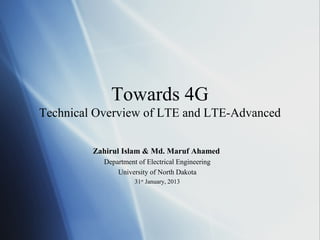
Lte presentation at und
- 1. Towards 4G Technical Overview of LTE and LTE-Advanced Zahirul Islam & Md. Maruf Ahamed Department of Electrical Engineering University of North Dakota 31st January, 2013
- 2. Outline
- 4. Fundamental Constraints Shannon’s capacity upper bound - Achievable data rate is fundamentally limited by bandwidth and signal-to-noise ratio (SNR)
- 5. Wider Bandwidth Demand for higher data rate is leading to utilization of wider transmission bandwidth.
- 6. Challenges of Wireless Communications
- 7. Duplexing Two ways to duplex downlink (base station to mobile) and uplink (mobile to base station) Frequency division duplexing (FDD) Time division duplexing (TDD)
- 11. Orthogonal Frequency Division Multiplexing OFDM can be viewed as a form of frequency division multiplexing (FDM). Divides the transmission bandwidth into narrower equally spaced tones, or subcarriers. Individual information symbols are conveyed over the subcarriers. Use of orthogonal subcarriers makes OFDM spectrally efficient. Because of the orthogonally among the subcarriers, they can overlap with each other.
- 12. Orthogonal Frequency Division Multiplexing (Contd.) Since the bandwidth of each subcarrier is much smaller than the coherence bandwidth of the transmission channel, each subcarrier sees flat fading.
- 13. Orthogonal Frequency Division Multiplexing (Contd.) Design issues of OFDM Cyclic prefix (CP): To maintain orthogonality among subcarriers in the presence of multi-path channel, CP longer than the channel impulse response is needed. Also CP converts linear convolution of the channel impulse response into a circular one. High peak-to-average power ratio (PAPR): Since the transmit signal is a composition of multiple subcarriers, high peaks occur. Carrier frequency offset: Frequency offset breaks the orthogonality and causes inter-carrier interference. Adaptive scheme or channel coding is needed to overcome the spectral null in the channel.
- 14. Orthogonal Frequency Division Multiple Access OFDMA is a multi-user access scheme using OFDM. Each user occupies a different set of subcarriers. Scheduler can exploit frequency-selectivity and multi-user diversity.
- 15. Single carrier FDMA (SC-FDMA) SC-FDMA is a new multiple access technique. Utilizes single carrier modulation, DFT-spread orthogonal frequency multiplexing, and frequency domain equalization. It has similar structure and performance to OFDMA. SC-FDMA is currently adopted as the uplink multiple access scheme in 3GPP LTE.
- 16. SC-FDMA and OFDMA Similarities Block-based modulation and use of CP Divides the transmission bandwidth into smaller subcarriers Channel inversion/equalization is done in the frequency domain SC-FDMA is regarded as DFT-precoded or DFT-spread OFDMA Dissimilarities Lower transmit peak power Equalization performance Multi0carrier MIMO receiver algorithm
- 17. MIMO Multiple input multiple output (MIMO) technique improves communication link quality and capacity by using multiple transmit and receive antennas. Two types of gain: Spatial Diversity: Improves link quality (SNR) by combining multiple independently faded signal replicas. Spatial Multiplexing: Increases data throughput by sending multiple streams of data through parallel spatial channels.
- 18. LTE: Long Term Evolution Standardized by 3GPP (3rd generation Partnership Project) 3GPP is a partnership of 6 regional standards organizations. ARIB (Japan) ATIS (USA) CCSA (China) ETSI (Europe) TTA (South Korea) TTC (Japan)
- 20. Requirement of LTE Peak data rate 100 Mbps DL/50 Mbps UL within 20 MHz bandwidth Up to 200 active users in a cell (5 MHz) Less than 5 ms user-plane latency Mobility Optimized for 0~15 km/hr 15~120 km/hr supported with high performance Supported up to 350 km/hr or even up to 500 km/hr Enhanced multimedia broadcast multicast service (E- MBMS) Spectrum flexibility: 1.25 ~ 20 MHz Enhanced support for end-to-end QoS
- 21. Key Features of LTE (R8) Spectrum flexibility: 1.25 ~ 20 MHz (100 MHz for LTE-A) Multicarrier-based radio air interface OFDM/OFDMA and SC-FDMA Support for both FDD and TDD spectrums Active interference avoidance and coordination Peak data rate Downlink (DL): 326.4 Mbps (20 MHz, 4x4 MIMO, 64-QAM) Uplink (UL): 86.4 Mbps (20 MHz, no MIMO, 64-QAM)
- 22. LTE-Advanced
- 23. LTE-A Features Wider bandwidths, enabled by carrier aggregation Higher efficiency, enabled by enhanced uplink multiple access and enhanced multiple antenna transmission (advanced MIMO techniques) Coordinated multipoint transmission and reception (CoMP) Relaying Support for heterogeneous networks LTE self-optimizing network (SON) enhancements Home enhanced-node-B (HeNB) mobility enhancements Fixed wireless customer premises equipment (CPE) RF requirements
- 24. LTE-A: Carrier Aggregation In order to support up to 100 MHz bandwidth, two or more component carriers aggregated Component carrier (CC): Basic frequency block which comply with R8 LTE numerology Each CC is limited to 20 MHz bandwidth (110 resource blocks) Maintains backward compatibility with R8 LTE Supports both contiguous and non-contiguous spectrum Also supports asymmetric bandwidth for FDD
- 25. LTE-A: Carrier Aggregation (Contd.)
- 26. LTE-A: Enhanced MIMO Downlink MIMO Up to 8x8 (8 layer) configuration Additional RS: CSI-RS and UE-specific DM RS Support for MU-MIMO Enhancements to CSI feedback Uplink MIMO Introduction of UL transmit diversity Introduction of up to 4x4 SU-MIMO Use of turbo serial interference canceller
- 27. Conclusion The 4G LTE technology is nothing less then ground breaking. The advancements that have been made from 3G to 4G LTE alone are mind blowing. With the data processing speed being increased to at least 100 Mbit/sec the possibilities are limitless in the wireless communication world. Everything with this new technology has been brought to a new standard. The security, with the complete IP-based solutions allows the user to use the full capability of the phone as well as feel completely secure at the same time, this is one of the most vital aspects that has been upgraded from the previous wireless communication technologies. Even though the hardware and coverage areas aren’t up to par yet though, isn’t that big of a set back. The technology is still considered brand new and will only be improved in the coming years. As I said previously, this technology is truly ground breaking and makes the average person really think about what is possible with wireless communication? If there ever is a 5G network, how powerful will it be and what will it possibly be able to do that the 4G doesn’t already do?
- 28. Thank you !!!
